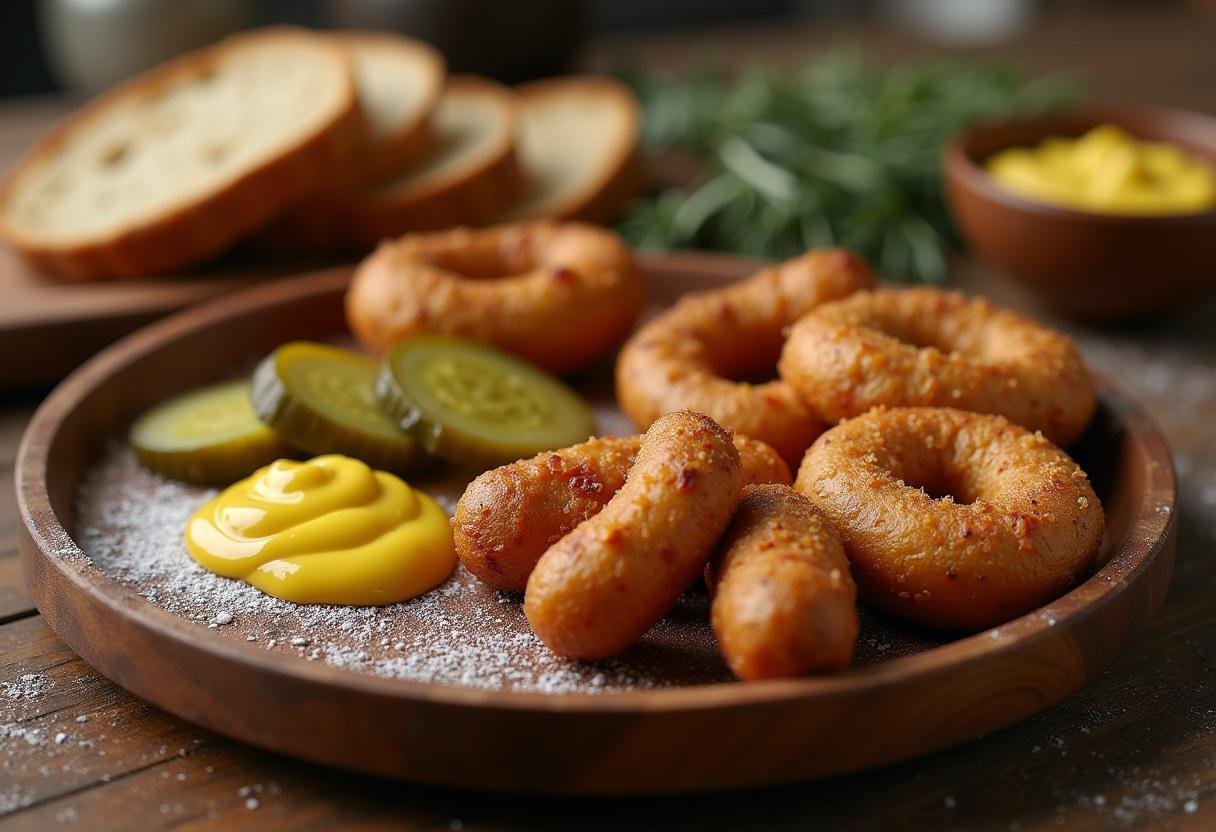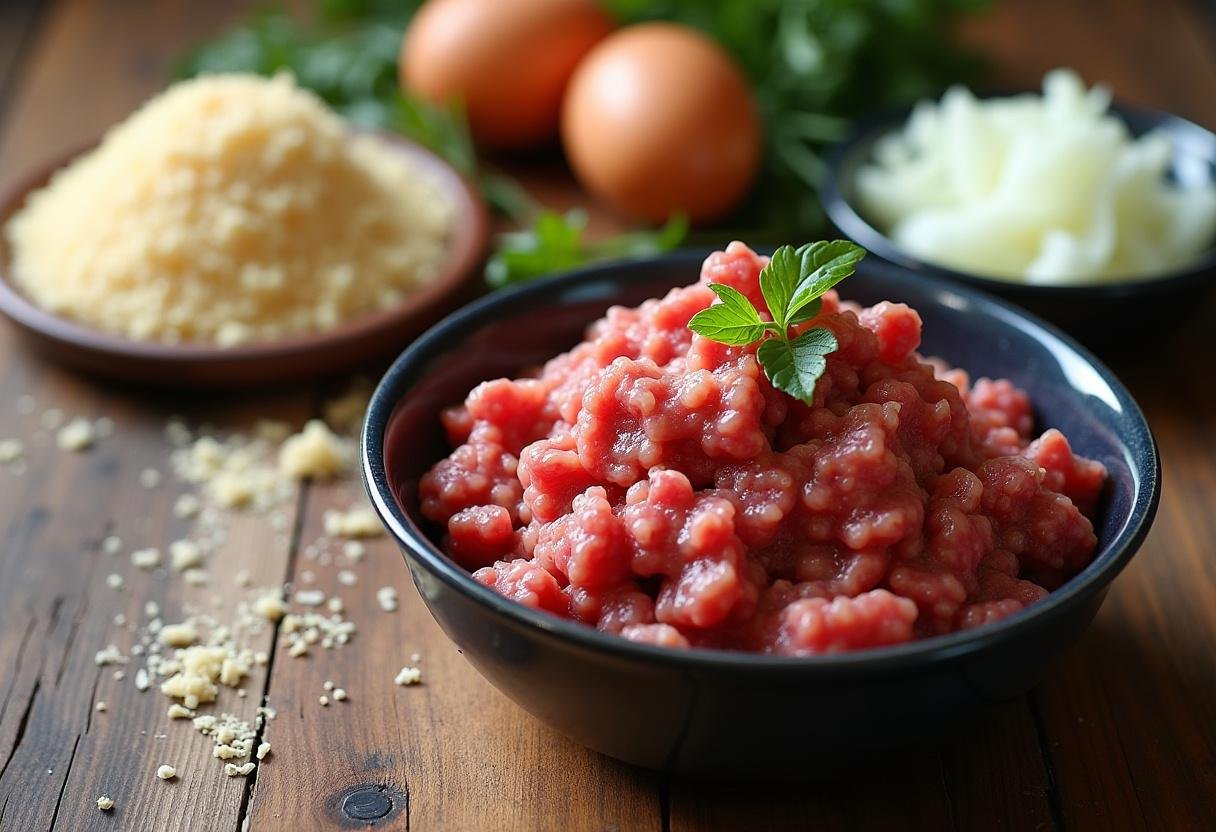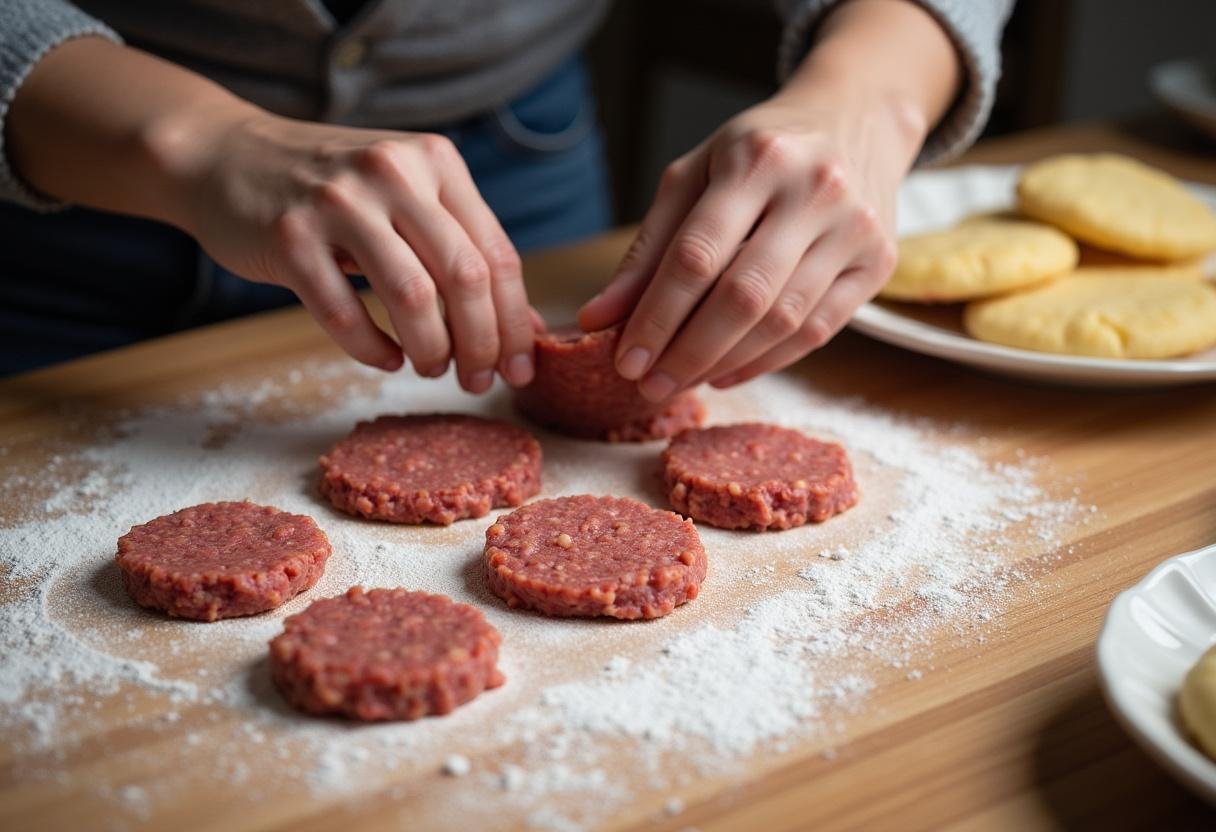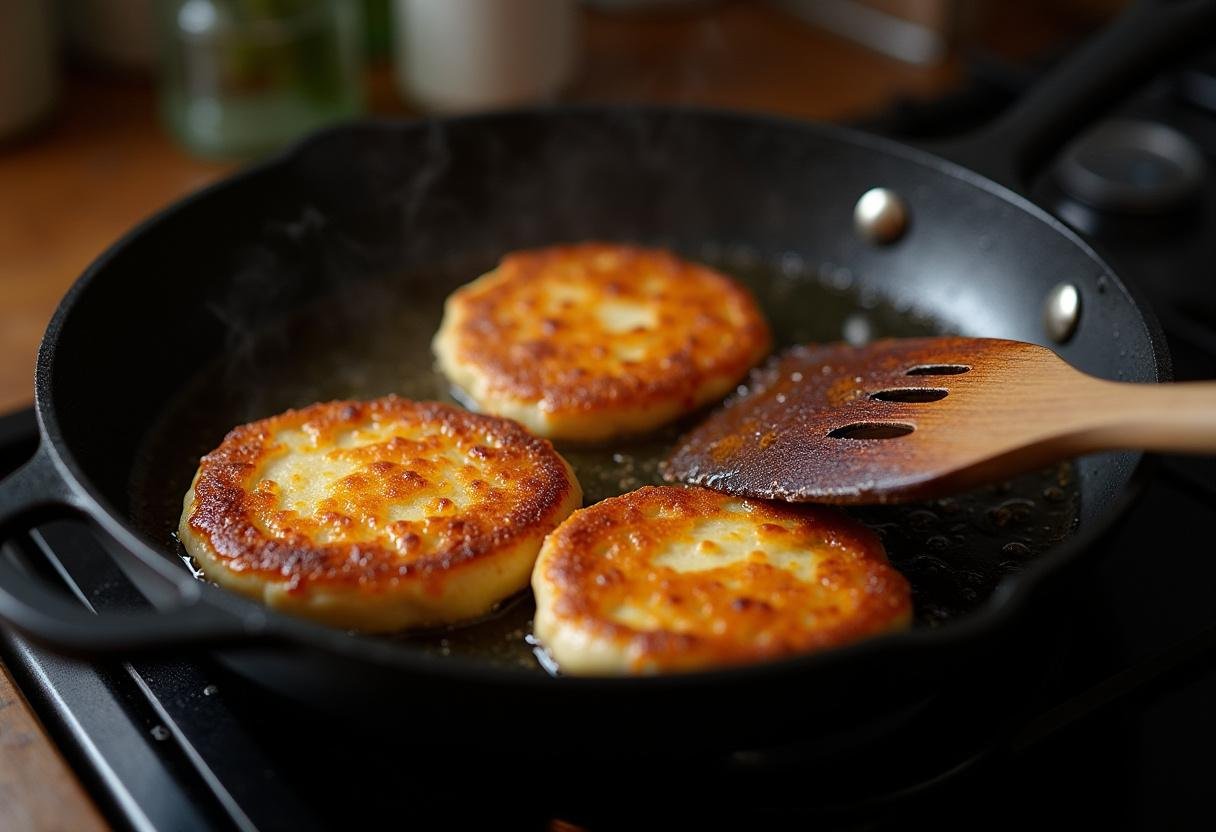How to Make German Frikadellen – Hearty & Delicious! The Ultimate Comfort Food Guide 🥩✨
1. Introduction to German Frikadellen
German Frikadellen (also known as Buletten or Frikadeller) are the ultimate comfort food that has been warming German hearts for generations. These juicy, flavorful meat patties combine the richness of ground beef and pork with aromatic seasonings, creating a dish that’s perfect for family dinners or casual gatherings. Unlike regular burgers, Frikadellen have a distinctive texture and flavor profile that makes them uniquely German. Whether you’re exploring German recipes for the first time or looking to perfect your technique, this guide will walk you through every step to create authentic, restaurant-quality Frikadellen at home.

2. Ingredients for Perfect Frikadellen
To make about 8 medium-sized Frikadellen, you’ll need:
- 500g ground meat (ideally 60% beef and 40% pork for optimal flavor)
- 1 small onion, very finely diced (about ½ cup)
- 1 large egg (acts as the perfect binder)
- 50g breadcrumbs (or try panko for extra crispiness)
- 100ml milk (whole milk works best for moisture)
- 1 tsp Dijon mustard (adds depth of flavor)
- 1 tsp sea salt (adjust to taste)
- ½ tsp freshly ground black pepper
- ½ tsp sweet paprika (for that signature German taste)
- 2 tbsp fresh parsley, finely chopped (or 1 tbsp dried)
- 2 tbsp butter or neutral oil for frying (butter adds amazing flavor)
Pro Tip: For a special occasion, try adding ¼ tsp of nutmeg – a secret ingredient many German grandmothers swear by! If you love experimenting with flavors, check out our Millionaire Brownies for another rich, decadent recipe.
3. Detailed Step-by-Step Instructions
Step 1: Preparing the Meat Mixture
In a large mixing bowl, combine all ingredients except the frying fat. The key to perfect Frikadellen is thorough mixing – use your hands to knead the mixture for about 3-4 minutes until everything is evenly distributed and the texture becomes slightly sticky. This develops the proteins in the meat, ensuring your patties hold together beautifully. Cover the bowl with plastic wrap and let it rest in the refrigerator for 15-30 minutes. This resting period allows the breadcrumbs to fully absorb the milk and the flavors to meld together perfectly.

Step 2: Shaping the Patties
Moisten your hands with cold water to prevent sticking. Take about ¼ cup of the mixture (about 80g) and gently form it into a ball, then flatten it to about 2cm (¾ inch) thickness. Traditional Frikadellen are slightly oval rather than perfectly round. Make a small indentation in the center of each patty with your thumb – this prevents them from puffing up too much during cooking. Place the shaped patties on a plate or baking sheet lined with parchment paper. If you’re making them ahead, you can refrigerate at this stage for up to 8 hours.

Step 3: Cooking to Perfection
Heat a large heavy-bottomed skillet (cast iron works great) over medium heat. Add 1 tablespoon of butter or oil. When the fat is hot but not smoking, carefully add the patties, leaving space between them (cook in batches if needed). Fry for 4-5 minutes on the first side until beautifully browned. Resist the temptation to move them around – let them develop that perfect crust. Flip carefully using a spatula and cook for another 4 minutes on the second side. For extra assurance, you can check the internal temperature with a meat thermometer – it should read 71°C (160°F). Transfer to a plate lined with paper towels to drain excess fat.
For alternative cooking methods, check out this Allrecipes version that includes baking instructions.

Step 4: Serving Suggestions
Serve your Frikadellen hot with traditional German accompaniments: spicy mustard, pickles, and perhaps some sweet sides to balance the savory flavors. They’re excellent with:
- Creamy mashed potatoes and rich gravy
- Warm potato salad (the German vinegar-based kind)
- Buttered spaetzle or egg noodles
- A simple green salad with vinaigrette
- On a crusty roll with all the fixings for a German-style burger

4. Chef’s Tips for Perfect Frikadellen Every Time
- Meat selection: Ask your butcher for a coarse grind – it gives better texture than pre-packaged fine ground meat.
- Breadcrumb alternatives: Soak 2 slices of white bread (crusts removed) in the milk instead of using dry breadcrumbs for extra tenderness.
- Onion technique: For smoother texture, grate the onion rather than dicing it.
- Resting is crucial: Never skip the resting time after mixing – it makes all the difference in texture.
- Perfect browning: Make sure your pan is properly heated before adding the patties to prevent sticking.
5. Creative Variations to Try
Once you’ve mastered the basic recipe, try these delicious twists:
- Cheese-Stuffed: Press a cube of Emmental or Gouda into the center of each patty before cooking
- Mushroom: Add ½ cup finely chopped sautéed mushrooms to the mixture
- Breakfast style: Serve with a fried egg on top – perfect for brunch
- Mediterranean: Mix in sun-dried tomatoes and feta cheese
- Spicy: Add 1 tsp curry powder for a northern German twist
6. Storage & Reheating Instructions
Frikadellen store beautifully:
- Refrigerator: Keep in an airtight container for up to 3 days
- Freezer: Freeze individually on a tray, then transfer to bags for up to 2 months
- Reheating: Thaw overnight if frozen. Reheat in a 180°C (350°F) oven for 10-15 minutes or in a skillet over medium-low heat until warmed through
They make excellent next-day sandwiches or can be chopped up for quick snacks.
7. Frequently Asked Questions
Can I make Frikadellen ahead of time?
Absolutely! You can prepare the mixture up to a day in advance (keep refrigerated) or shape and freeze raw patties for future use. They actually taste better when the flavors have time to develop.
What’s the difference between Frikadellen and meatballs?
While similar, Frikadellen are typically larger, flatter, and contain more breadcrumbs and milk, giving them a distinctive texture. They’re also usually pan-fried rather than baked or simmered in sauce.
Can I make these gluten-free?
Yes! Simply substitute gluten-free breadcrumbs or crushed gluten-free crackers. The texture will be slightly different but still delicious.
Why do my Frikadellen fall apart when cooking?
This usually happens if: 1) The mixture wasn’t kneaded enough, 2) You didn’t let it rest before cooking, or 3) You flipped them too soon. Make sure to follow the resting and cooking times carefully.
8. The Cultural Significance of Frikadellen
In Germany, Frikadellen are more than just food – they’re a cultural icon. Known as Buletten in Berlin, Frikadellen in the north, and Fleischpflanzerl in Bavaria, these meat patties are a staple of home cooking and beer garden menus alike. They represent German practicality and love for hearty, satisfying food. Many Germans have fond childhood memories of their grandmother’s special Frikadellen recipe, often passed down through generations.
9. Perfect Pairings
Complete your German meal experience with these perfect accompaniments:
- Drinks: A cold German pilsner or apple spritzer (Apfelschorle)
- Bread: Freshly baked rye bread or pretzel rolls
- Dessert: Follow your savory meal with our Butterbeer Cookies or Easter Crack for a sweet finish
10. Final Thoughts
Mastering German Frikadellen is a culinary skill that will serve you for years to come. These versatile patties are perfect for weeknight dinners, weekend cookouts, or even elegant dinner parties when served with the right sides. The beauty of this recipe lies in its simplicity and the way it can be adapted to your personal taste. Whether you stick to the traditional version or experiment with creative variations, one thing is certain – once you try homemade Frikadellen, you’ll understand why they’ve been a German favorite for centuries. Guten Appetit! 🍽️🇩🇪
Looking for more international inspiration? Browse our complete recipe collection for delicious ideas from around the world!
Print
How to Make German Frikadellen – Hearty & Delicious!
German Frikadellen, also known as Buletten or Frikadeller, are a beloved comfort food in Germany. These juicy, flavorful meat patties are made from a mix of ground beef and pork, seasoned to perfection, and pan-fried until golden brown. Whether served with mustard, pickles, or a side of mashed potatoes, German Frikadellen are a hearty and satisfying dish that brings warmth to any meal.
- Total Time: 25 minutes
- Yield: 6 Frikadellen
Ingredients
- 500g ground beef (or a mix of beef and pork)
- 1 small onion, finely diced
- 1 egg
- 50g breadcrumbs
- 100ml milk
- 1 tsp mustard
- 1 tsp salt
- ½ tsp black pepper
- ½ tsp paprika
- 2 tbsp fresh parsley, chopped
- 2 tbsp butter or oil for frying
Instructions
- In a large bowl, combine the ground beef, finely diced onion, egg, breadcrumbs, milk, mustard, salt, pepper, paprika, and chopped parsley. Mix everything thoroughly until well combined. Let the mixture rest for 10 minutes to allow the flavors to meld.
- Wet your hands slightly to prevent sticking, then take a portion of the meat mixture and shape it into a round patty, about 2 cm thick. Repeat until all the mixture is used.
- Heat butter or oil in a large frying pan over medium heat. Once hot, add the patties and cook for about 4-5 minutes per side, until golden brown and cooked through.
- Transfer the cooked Frikadellen to a plate lined with paper towels to absorb excess oil. Serve hot with mustard, pickles, or your favorite side dish.
Notes
- Use a mix of beef and pork for the best flavor and texture.
- Let the meat mixture rest before shaping to enhance juiciness.
- Don’t overcrowd the pan—fry in batches if needed.
- For extra crispiness, press the patties slightly thinner before frying.
- Prep Time: 15 minutes
- Cook Time: 10 minutes
- Category: Main Dish
- Method: Pan-Frying
- Cuisine: German
- Diet: Non-Vegetarian
Nutrition
- Serving Size: 1 Frikadelle
- Calories: 250 kcal Kcal
- Sugar: 1g
- Sodium: 400mg
- Fat: 15g
- Saturated Fat: 6g
- Unsaturated Fat: 7g
- Trans Fat: 0g
- Carbohydrates: 8g
- Fiber: 1g
- Protein: 20g
- Cholesterol: 90mg

